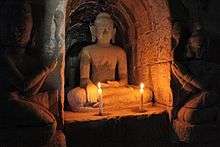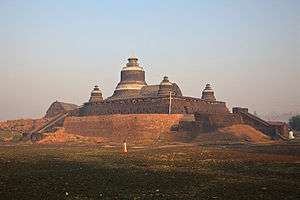Htukkanthein Temple
| Htukkanthein Temple Cross-Beam Ordination Hall | |
|---|---|
|
Htukkanthein Temple | |
 Location within Burma | |
| Basic information | |
| Geographic coordinates | 20°35′52″N 93°11′29″E / 20.59778°N 93.19139°ECoordinates: 20°35′52″N 93°11′29″E / 20.59778°N 93.19139°E |
| Affiliation | Theravada Buddhism |
| Country | Myanmar |
| Architectural description | |
| Founder | King Min Phalaung |
| Completed | 1571 |
Htukkanthein (Burmese: ထုက္ကန့်သိမ်, pronounced 'Htoke-kan-thein' in Arakanese) is one of the most famous temples in the ancient Arakanese city of Mrauk U, in Rakhine State, Western Myanmar. The name means "Cross-Beam Ordination Hall".
Like most of Mrauk U's Buddhist temples, it is designed as a dual purpose 'fortress-temple'. Although it is a 'thein' (Ordination Hall), it is one of the most militaristic buildings in Mrauk U, built on raised ground, with a single entrance and small windows. According to Dr. Emil Forchhammer, an archaeologist employed by the British Raj to study Mrauk U in the late 19th century, the temples might have been employed as a refuge for the Buddhist religious order in times of war.

The temple enshrining the statues of Buddha was built in 1571 by King Min Phalaung. It is located on a small hill a stone's throw away from the Shite-thaung Temple. At the centre of the temple is a dome topped with a mushroom shaped crown or hti, surrounded by four smaller stupas at the corners. At the facade base of the central dome is a square window designed in such a manner that, at dawn, the sun's rays shine directly onto the main Buddha image inside the central vault. At the west side of the temple is a small meditation chamber, accessible only via the main temple.
The temple is constructed of brick and stone.
The Htukkanthein has three chambers, rotating clockwise inwards. The entire temple has a total of 180 Buddha images in niches (179 smaller ones along the corridors, and 1 at the central vaulted chamber). On each side of the niches are sculpted male and a female figures said to represent the donors who made the construction of the temple possible.
See also
References
- Pamela Gutman (2001) Burma's Lost Kingdoms: splendours of Arakan. Bangkok: Orchid Press
